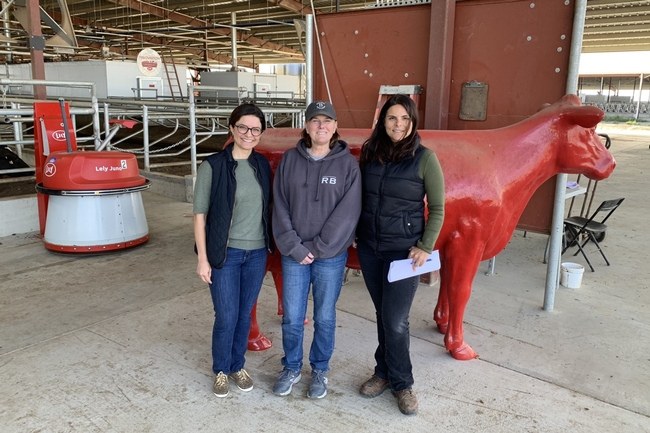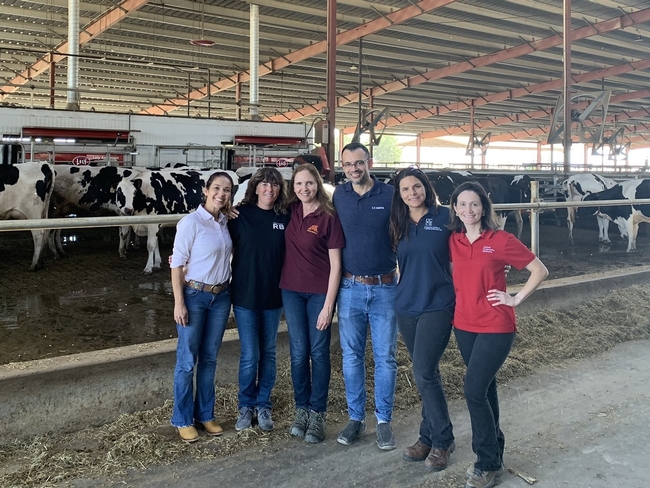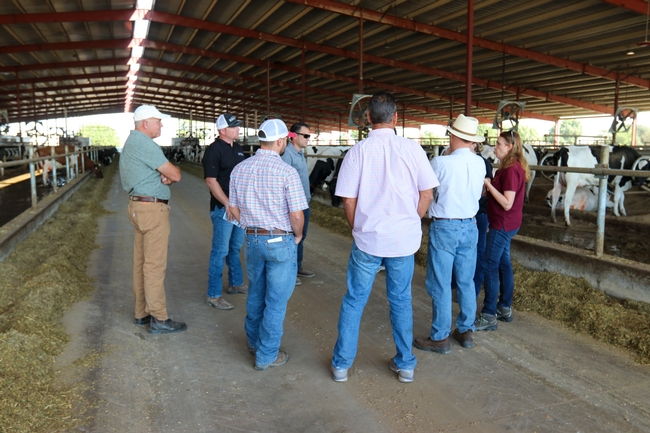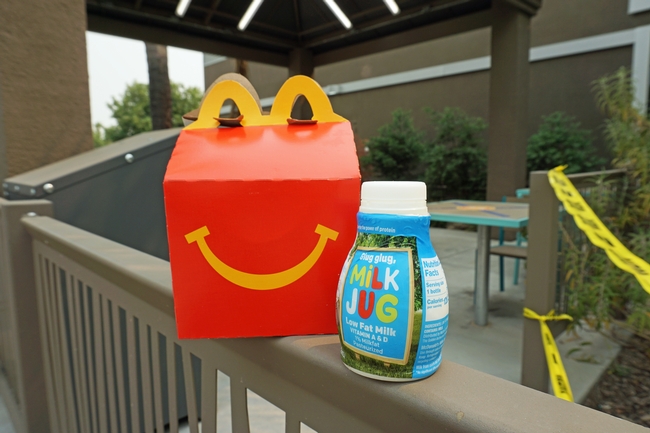Posts Tagged: milk
UCCE advisor Bruno guides, learns from dairies switching to milking robots
Automatic milking systems increasingly used in California amid labor challenges
When third-generation dairy farmer Shonda Reid first saw a milking robot at a farm show 13 years ago, she immediately recognized that the technology represented the future. Her father, however, took a bit more convincing.
“I came home and showed him and said, ‘This is what we need to do.' And he thought I was kidding!” said Reid, dairy and farm manager for Fred Rau Dairy, which has a herd of 1,400 milk cows in Fresno County.
Years later, after the family had visited several dairies using automatic milking systems (AMS) across the U.S., they installed their first six robots in November 2021. By fall 2022, they had 24 robots, evenly split between two newly built “free stall” barns where the cows can freely go to the milking machines.
As Fred Rau Dairy was one of the first in California to implement AMS at such a scale, Reid and her team have been instrumental in growing practical knowledge on these systems. She also has been a valued partner to Daniela Bruno, University of California Cooperative Extension dairy advisor for Fresno, Madera and Kings counties.
“Automatic milking robots are not a new technology, but it's new to California,” said Bruno, noting that the milking robots were first used on small, family-run farms in Europe, where the technology granted family members more time for rest and other pursuits.
To better understand the feasibility of milking robots for large dairies in California, Bruno – alongside former UC Davis School of Veterinary Medicine professor Fernanda Ferreira, University of Minnesota researcher Marcia Endres and other collaborators – began a project in 2020 to study the risks and opportunities of automated systems.
“The information is extremely useful for California producers to make informed decisions about implementing AMS on their facilities,” said Denise Mullinax, executive director of the California Dairy Research Foundation, which supported the effort through a competitive grant. “Cow care, labor requirements and profitability are key issues for producers, and CDRF was pleased to support this project which assists producers in understanding how AMS may impact those areas on their facility.”
Dairy farmer: ‘We needed to make some changes'
The project produced a paper analyzing existing research on automatic systems, which have been more widely used in the Midwest, where there are more small-scale, family-run dairies. In 2020, there were only 14 “box robots” in California, according to Bruno. Now there are about 200 across California – and both Bruno and Reid cited labor challenges as the primary reason for the increased use of automated systems.
“California suffers from labor quality and quantity issues,” Bruno said. “By bringing robots to California, you can minimize those problems.”
Higher costs of hiring and retaining employees, driven in part by new labor laws, are one factor. And then there's the reliability and availability of labor, as fewer people are willing to do the physically demanding work of conventional milking.
“People just don't want to milk in a flat barn [a conventional setup where the employee works at the same level as the cow] – there's a lot of kneeling, squatting, that type of thing – it's pretty tough on the body,” Reid explained.
Faced with labor shortages and mounting regulatory burdens, Reid said Fred Rau Dairy had to make the leap to automated systems to keep the 80-year-old dairy operation running.
“We needed to make some changes, or we're going out of the dairy business,” she said.
In a survey conducted by Bruno and her colleagues of large dairies using AMS across the U.S., a majority of the 29 respondents reported reductions in labor costs – but survey results did not offer a definitive picture on whether AMS improved bottom-line profitability.
Calmer, healthier cows
Nevertheless, most of the survey respondents said they were generally happy with their transition to automatic systems.
“It's totally met our expectations, and cow health has gotten much better, too,” Reid said.
In a typical conventional system where cows are outside in “open corral” pens, dairy employees must cajole the cows into the milking parlor. But within a “free stall” barn where the cows can voluntarily go to the milking robots when they want, as often as they want, the animals are much less stressed.
“When you think about cow handling, if you have robots, you don't have anybody pushing and screaming at them to walk to the parlor,” Bruno explained. “You have less cow-people interaction so they are more calm; there is less stress.”
In the survey of large dairies using milking robots, more than 90% of the respondents said their cows were calmer. Reid also noted that many people have noticed how calm their cows are in the free stall barns.
“They're not skittish, you can walk in and they don't run,” Reid said. “They'll just watch you or they'll even come up and start licking on your jacket or shirt.”
Bruno also said that many of the large dairies reported fewer cases of mastitis and other diseases, less lameness, and greater milk production. But she added it's hard to know whether the benefits can be attributed to the robots and their real-time monitoring technology – or to changes in the physical environment (cows save energy in the free stall barn setup, versus the open-corral system that requires walking to the milking parlor).
Dairy producers seek counsel on potential transition
Less bovine travel from outside to inside was a boon for Fred Rau Dairy during last year's unusually wet winter.
“Even if it's just a couple of weeks of rain, that mud and manure and everything – you do what you can, but oh my gosh – it's a mess,” said Reid, noting that easier facility maintenance during extreme weather was another benefit of switching to automatic systems within free stall barns.
Reid shared many of her experiences with attendees of an AMS Field Day in October 2022, arranged by Bruno, Ferreira and their collaborators. About 60 farmers, researchers, industry representatives and consultants visited Fred Rau Dairy and Jones Dairy in Merced County.
If a dairy producer is considering implementing automatic systems, Reid recommends that they research all their options, visit dairies that use the systems, and check who in their area would be providing service and technical support.
And there are crucial workforce considerations, as dairy workers must learn an entirely new set of skills and processes. Instead of spending their time fetching the cows, prepping them and milking them in the parlor, workers might need to gather and interpret data from the robots. “Cow people,” as Reid puts it, must become computer people.
“You have a group of people who have been with you for a while, and you hope that they can transition to the new technology of what you're doing,” Reid said.
During this technological transition, and on the myriad other challenges that dairy operators face, Reid said she is grateful for Bruno's expertise and responsiveness.
“If there's something that I need, she's been really good about trying to help – or putting me in contact with the right people,” she explained. “I've enjoyed working with her.”
The AMS project team also includes UC Davis School of Veterinary Medicine professor Fabio Lima, postdoctoral researcher Thaisa Marques and former postdoctoral researcher Camila Lage.
New policies can inspire families to provide healthy beverages to children
At fast food and sit-down restaurants across California, kids' meals come with water or milk automatically. At least, that should be the case since state law requires restaurants to offer the healthy beverages by default to reduce the amount of sugary beverages served to children.
California Senate Bill 1192, authored by Sen. Bill Monning (D-San Luis Obispo), went into effect Jan. 6, 2019, but research by the UC Nutrition Policy Institute (NPI) has found that implementation has not been universal and more can be done. The results, along with results from a similar study in Wilmington, Del., were published Aug. 20 on HealthyEatingResearch.org.
Before the law, 10% of menu boards observed by the researchers in California listed only the healthy beverages. Data collected after the law went into effect showed 66% of menu boards list the healthy default beverages. The researchers also collected data on the proportion of cashiers who verbally offered only healthy beverages with kids' meals when orders were placed. This happened only 5% of the time before the law was enacted, and dropped to 1% after.
“Parents look at menu boards and kids look at menu boards, but it is likely that what the cashier says also influences which drink they choose,” said Lorrene Ritchie, NPI director and UC Cooperative Extension nutrition specialist. Ritchie was the lead researcher on the California portion of the study. “In our data collection, we would order a kids' meal and wait for them to offer a drink. But mostly they said, ‘What drink do you want?' instead of ‘Do you want water or milk with that?'”
The law doesn't specify whether the cashier must offer the default beverages, but the spirit of the law suggests they should, as it would likely have a greater impact on the selections that children and parents make, Ritchie said.
According to Gail Woodward-Lopez, an NPI researcher and co-investigator on the study, most restaurant managers expressed support for the legislation, but didn't know much about it.
“NPI in partnership with the California Department of Public Health is working with some local health departments to provide training and materials to help restaurants comply with the letter and spirit of the law,” Woodward-Lopez said. “Our next step is to measure whether this health department support is effective.”
The dire need to direct children away from sugary sodas is clear. Empty calories from soda and other sugar-sweetened beverages is the No. 1 cause of obesity in children, Ritchie said. Obese children are at least twice as likely as non-obese children to become obese adults. Obese children and adults are at greater risk for Type 2 diabetes, heart disease, stroke, high blood pressure, high cholesterol, certain cancers, asthma, low self-esteem, depression and other diseases. The Centers for Disease Control and Prevention names obesity as one of the conditions that increase risk of severe illness from COVID-19.
Many open questions remain, such as how drinks are portrayed on drive-thru signs and offered by drive-thru order takers. The COVID-19 pandemic has also altered the way Americans purchase food, with increased online ordering, delivery and drive-thru usage. In-store kiosk ordering is also growing in popularity.
“The role of default beverage policies in this context is important and not well understood,” Woodward-Lopez said.
Woodward-Lopez and Ritchie are working with colleagues around California and across the country to design follow-up studies of newer food technologies and beverage policies being passed elsewhere, to determine how government policies can protect children's health by steering them toward healthy beverage consumption.
The newly published research was funded by the Robert Wood Johnson Foundation and by the California Department of Public Health with funding from the United States Department of Agriculture.
How to support your breastfeeding employees when they are out in the field
New parents returning to work after the birth of a child face a lot of questions and uncertainties, particularly around breastfeeding. Should I continue to breastfeed? Will there be a space for me to pump milk in private? What will my boss and co-workers say? How many times should I pump when I am away from my baby?
Recognizing the importance of breastfeeding to the health of both parent and child, California recently passed AB 1976 to strengthen protections for working parents that want to continue to breastfeed and need to express milk (i.e., pump) at work. Starting on Jan. 1, 2019, employers must make reasonable efforts to provide a private area to pump that is not a bathroom or face fines and penalties. Prior to 2019, some employers would designate a bathroom as their lactation room, a practice that was technically “ok” so long as the toilet was behind a stall or other barrier. Now that practice is expressly prohibited and employers will need to find another space to accommodate lactating employees.
So, what happens when an employer cannot provide a permanent, private area due to operational or financial conditions? Many new parents might find themselves in just this position. Agricultural workers or field researchers may not work in a traditional office or they may find themselves at off-site locations for a large percentage of their work day. At UC Agriculture and Natural Resources, many employees travel across multiple counties delivering community health education lessons at various sites. AB 1976 includes provisions for setting up temporary lactation locations so long as the space is private, only used for that purpose while the employee is expressing milk, and otherwise meets the requirements of state law concerning lactation (again, it cannot be a bathroom).
Lactation locations when out in the field
To be compliant with state law, avoid fines and penalties and support the health of their employees, employers may need to set-up a temporary lactation station for their workers. AB 1976 specifically states that agricultural employers are compliant if they provide a “private, enclosed, and shaded space, including, but not limited to, an air-conditioned cab of a truck or tractor.”
One solution is to assemble a mobile lactation unit that employees can check out or reserve based on their pumping schedule. Mobile lactation stations can take many forms, however, some basics that should be included in a lactation unit are listed and itemized below.
Privacy screens and supplies
To be compliant, the space needs to be private and free from intrusion. When setting up the mobile station in a vehicle, you will need to have privacy screens that fit all vehicle windows front, back and sides. There are many options on the market ranging in price from $20 on up. When ordering window shades, you will need to know the make and model of the vehicle.
- Privacy screens for front, back and side windows (4 total, $21 each) = $84
- Signage and door locks to prevent intrusion or knocking
Food safety supplies
Remember, breast milk is food. Helping your employee keep their expressed breast milk safe for their baby will result in less illness and less time off work. Some basics:
- Sanitizing surface wipes: These will be used to sanitize the space including the seat, dashboard or other surfaces that may come in contact with the lactation equipment. Large container of surface sanitizing wipes = $5
- Hand sanitizing wipes: Unless there is always a sink in close proximity, your employee will want to wash their hands before and after pumping. If their hands are very dirty they will need to have a place where they can remove all dirt and debris before using the hand sanitizing wipes. Hand sanitizing wipes = $4
- Cooler bag, ice pack and thermometer for the employee to store the expressed milk safely. The cooler size and number of ice packs needed will depend on the conditions where the milk will be stored. A small cooler with one ice pack will heat up quickly on a hot day. The thermometer will give the employee peace of mind that the milk stayed below 40 degrees and is safe for the child. Leaving/storing a cooler with expressed milk in the trunk or interior of car will increase the temperature in the cooler more quickly. Instead, find a shaded location when possible. 1 cooler bag (approx. $15) + ice packs (approx. $8) + cooler thermometer (approx. $2) = $25
- Backpack or bag: To store these items when the lactation space is being used for other purposes (e.g., driving), you will need a backpack or bag. Costs can vary, however, the bag should be large enough to fully contain all of the items and ensure that they are not contaminated by other materials that may be placed around or near the supplies. You will want it to have a zipper and an easy-to-clean material on the outside and inside (e.g., vinyl or plastic-coated fabric). Cost is variable $5 to $150 depending on your style and budget needs.
- Closed trash receptacle for all used cleaning wipes. Approx. $5
Additional item

Support for breastfeeding employees is not only a company perk, it's the law. Under certain circumstances, employers can set-up these mobile lactation stations for their field-based employees for under $150. What better way to promote employee health, avoid fines and penalties and support local families?
Changes in breast milk sugars impact babies’ health and growth
When it comes to nursing moms and their babies, an elegant web of cause and effect connects climate, breast milk, gut microbes and infant health.
That web was clearly illustrated by a recently published study involving 33 women and their babies in the West African nation of The Gambia. The research team, including scientists from UC Davis and UC Agriculture and Natural Resources, found that complex breast milk sugars called oligosaccharides helped protect nursing babies from illness and also influenced the mixture of microbes in the infants' guts.
The researchers also showed that changes in food availability from season to season could affect the composition of the women's breast milk and the protective quality of the babies' gut microbiota. And those changes, in turn, impacted the health and growth of the breastfed infants.
Composition of breast-milk sugars and infant health
Oligosaccharides occur abundantly as more than 200 different chemical structures in human breast milk. It's been known for some time that these complex sugars contribute to infant health by supporting the growth of beneficial bacteria in the baby's gut. And these gut bacteria have been shown to play a key role in fending off infectious illnesses.
But little has been known about how changes in the composition of the breast milk sugars might affect the health and growth of infants, especially those living in areas where infection rates are high.
To explore that relationship, the researchers monitored the composition of the oligosaccharides in the mothers' milk and examined the infants' gut microbiota at 4 weeks, 16 weeks and 20 weeks after the babies were born. Then they analyzed the data, looking for possible relationships to the health and growth of the babies and the status of their gut microbes.
They found that two of the oligosaccharides, lacto-N-fucopentaose and 3′-sialyllactose, had a direct relationship to the babies' health and growth. High levels of the former were associated with a decrease in infant illness and with improved growth, measured as height for age, while the latter proved to be a good indicator of infant growth, measured by weight per age.
“Our findings provide evidence that specific human milk oligosaccharides can alter the composition of breast milk, making it more protective against infection and allowing the infant to invest energy in growth rather than fending off disease,” said the study's corresponding author Angela Zivkovic, an assistant professor of nutrition at UC Davis.
Influence of wet and dry seasons
The researchers also were curious how seasonal shifts in food availability, which significantly impact the mothers' diets, might be reflected in breast milk composition and infant health.
The Gambia has two distinct seasons, the wet season from July to October and the dry season from November to June.
The wet season is also known as the “hungry” season because it is the time of year when food supplies tend to be depleted, infection rates rise and the farming workload is highest. In contrast, the dry, or “harvest,” season is characterized by plentiful food supplies as well as significantly higher energy stores and less illness among the local people.
The researchers found that mothers who were nursing during the wet or “hungry” season produced significantly less oligosaccharide in their milk than did those nursing during the dry season.
In examining the makeup of the babies' gut microbiota, the researchers noted that most of the bacteria belonged to the Bifidobacteria genus. They also discovered that higher levels of Dialister and Prevotella bacteria were accompanied by lower levels of infection.
In addition, higher levels of Bacteroides bacteria were present in the infants' guts that had abnormal “calprotectin” – a biomarker associated with intestinal infections.
“We are very interested in which specific dietary factors influence the oligosaccharide composition of mother's milk,” Zivkovic said. “If we can find the mechanisms that change the composition of breast milk sugars, we may have a new approach for modifying the infant microbiota and ultimately influencing the health and vigor of the nursing baby.”
The study by Zivkovic and colleagues appears online in the journal Scientific Reports. The research is part of a long-running, cross-disciplinary project at UC Davis examining milk and its role in nutrition.
Funding for the study was provided by the National Institutes of Health, UK Medical Research Council, Bill and Melinda Gates Foundation, Alfred P. Sloan Foundation, and Peter J. Shields Endowed Chair in Dairy Food Science at UC Davis.
The debate over dairy products is being milked for all its worth

Robert Lustig, professor of pediatric medicine at UC San Francisco, said he believes drinking whole milk can lead to lower calorie intake overall because it is more filling than low-fat and non-fat alternatives.
A UC Agriculture and Natural Resources (UC ANR) expert shared a different viewpoint. Lorrene Ritchie, director of the UC ANR Nutrition Policy Institute, said low-fat or skim milk products are still preferable to whole milk because liquid calories are not as filling as equivalent calories from solid food. Nationwide, the goal for most people should be to reduce calorie intake.
"Until we decrease calorie intake on a population level, we are unlikely to see much reversal in the obesity epidemic," Ritchie said.
Before the end of 2015, the federal government is expected to release its revised Dietary Guidelines for Americans. According to the Guardian article, the guidelines are expected to tout vegetables, fruits, whole grains, legumes, nuts, seafood and "low- or non-fat dairy." The guidelines inform the USDA's dietary infographic, which at the moment takes the form of a plate half filled with vegetables and fruit, and the other half with a small portion of protein food and whole grains.
The Nutrition Policy Institute has been advocating for the addition of water on the MyPlate icon to reinforce its position that plain tap water is the best choice for quenching thirst.







